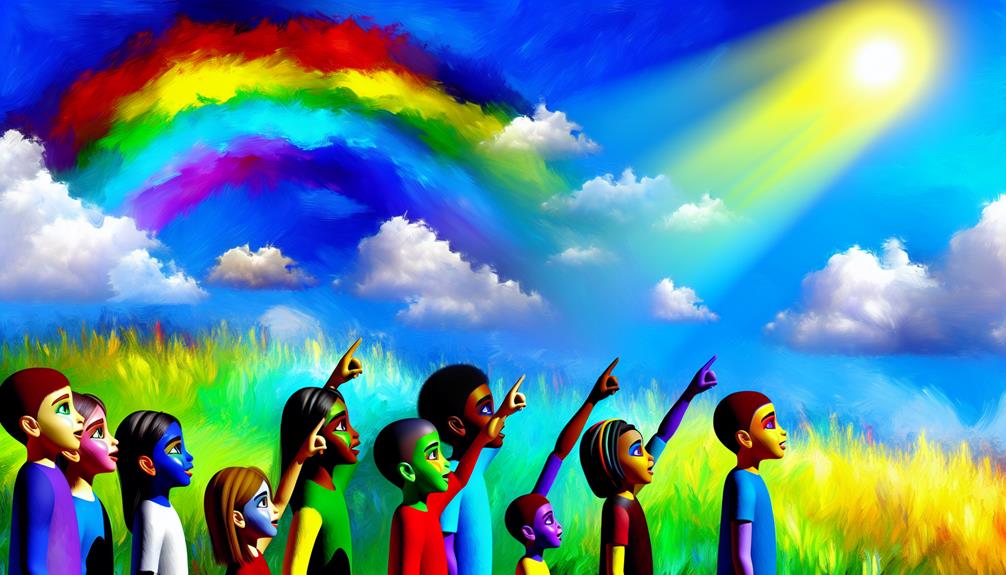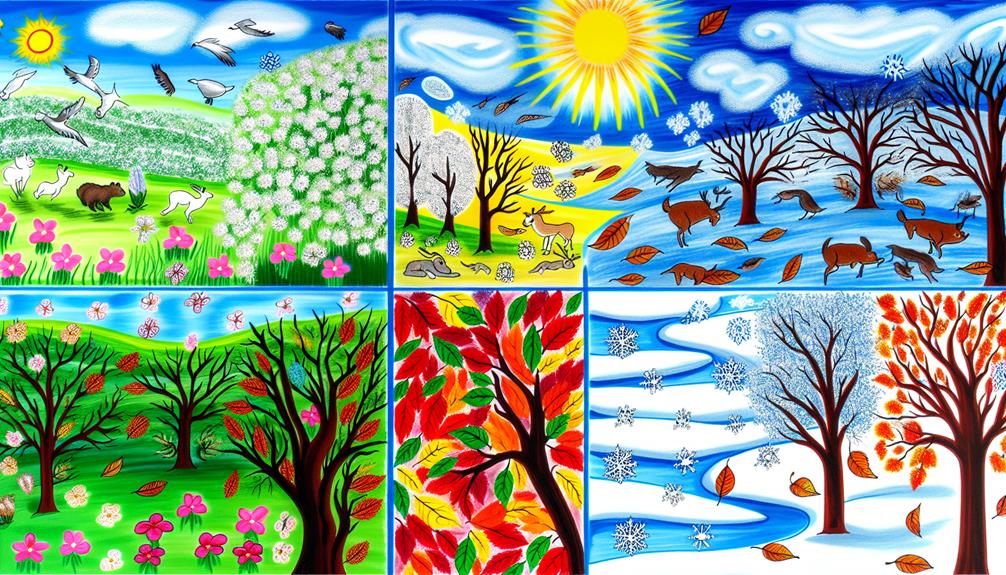Kid-friendly FAQs offer simple and engaging answers to common questions about the natural world. For instance, the sky appears blue due to sunlight scattering in the atmosphere. Rainbows form when light bends and reflects in raindrops, creating a spectrum of colors. Seasons change because of Earth's tilt, affecting how we receive sunlight. Leaves change color in autumn as chlorophyll diminishes, revealing other pigments. Animals sleep in varied ways, ensuring their health, while dreams help us process emotions and memories. Explore more fascinating insights about nature and the world around us to satisfy your curiosity.
Key Takeaways
- Kids often ask why the sky is blue, which is due to sunlight scattering in the atmosphere.
- Rainbows form when sunlight refracts and reflects inside raindrops, creating a spectrum of colors.
- Seasons change because of Earth's tilt, affecting how sunlight warms different regions throughout the year.
- Leaves change color in autumn as chlorophyll breaks down, revealing other pigments like carotenoids and anthocyanins.
- Animals have unique sleep patterns, with some resting one brain hemisphere to stay alert for predators.
Why Is the Sky Blue?

The sky appears blue due to a phenomenon known as Rayleigh scattering. This occurs when sunlight enters the Earth's atmosphere and interacts with atmospheric particles, such as oxygen and nitrogen molecules. Sunlight, or white light, is composed of various colors, each with different wavelengths. Blue light has a shorter wavelength than other colors, making it more susceptible to scattering. Notably, just as the sky can exhibit a range of colors, many culinary creations are enhanced by different sauces, such as essential Asian sauces, which can elevate dishes.
As sunlight passes through the atmosphere, the shorter blue wavelengths scatter in all directions, giving the sky its vibrant blue hue. On clear days, this scattering is most pronounced, leading to the beautiful array of sky colors we often admire. When the sun is low on the horizon, such as during sunrise or sunset, the light travels through more atmosphere, scattering the shorter wavelengths and allowing the longer wavelengths, like red and orange, to dominate. This explains the stunning colors we see during those times.
Understanding why the sky is blue helps foster a deeper appreciation for our natural world. By exploring the science behind sky colors, we can connect with the beauty around us, appreciating how even simple observations can reveal complex phenomena.
How Do Rainbows Form?
Rainbows form through a fascinating process called light refraction, which occurs when sunlight passes through raindrops in the atmosphere. This process is similar to how light interacts with plants, including those grown from the best heirloom seeds for medicinal gardening. As the light enters and exits the droplets, it bends and separates into a spectrum of colors, creating the beautiful arc we see in the sky. This vibrant display showcases the colors of the spectrum, including red, orange, yellow, green, blue, indigo, and violet.
Light Refraction Explained
A stunning display of colors often appears in the sky after a rain shower, enchanting both children and adults alike. This beautiful phenomenon, known as a rainbow, is a result of light refraction. When sunlight passes through raindrops suspended in the air, it undergoes light bending, causing the light to change direction.
As the light enters the raindrop, it slows down and bends—this is where the magic begins. Inside the drop, the light reflects off the inner surface before exiting back into the air. During this process, the different colors of light separate, much like how a prism creates a spectrum of colors. Each color bends at a slightly different angle, leading to the formation of a circular arc of colors in the sky.
The result is a breathtaking display of red, orange, yellow, green, blue, indigo, and violet. This enthralling sight not only brings joy but also teaches us about the wonders of light and nature. So, the next time you see a rainbow, remember the incredible journey sunlight takes to create such beauty!
Colors of the Spectrum
Seven distinct colors emerge in a rainbow, each representing a unique wavelength of light. These colors—red, orange, yellow, green, blue, indigo, and violet—form when sunlight interacts with water droplets in the atmosphere, creating a magical display that captivates both young and old. This phenomenon illustrates the principles of spectrum science and color mixing.
To understand how these colors are formed, consider the following table that highlights each color's characteristics:
| Color | Wavelength (nm) | Feelings Associated |
|---|---|---|
| Red | 620-750 | Excitement, Energy |
| Green | 495-570 | Harmony, Growth |
| Blue | 450-495 | Calmness, Trust |
When light refracts through water droplets, it splits into these beautiful colors, creating a visual bridge that connects us to nature. This enchanting process not only fosters appreciation for the beauty around us but also invites us to explore the wonders of spectrum science. Just as rainbows unite colors, they remind us of the importance of diversity and belonging in our lives.
What Causes Seasons?

Seasons are primarily caused by the tilt of the Earth on its axis and its orbit around the sun. This tilt leads to variations in sunlight distribution, resulting in different temperatures and weather patterns throughout the year. Recently, advancements in technology, such as those from electric vehicle companies, highlight the importance of understanding our planet's environment and climate. exciting new developments from Tesla showcase the ongoing efforts to address climate change. Understanding these concepts helps explain why we experience spring, summer, autumn, and winter.
Earth's Tilt and Orbit
Earth's unique tilt and orbit around the Sun play an essential role in determining the seasons we experience. The planet is tilted at an angle of approximately 23.5 degrees, known as its axial tilt. This tilt causes variations in solar radiation received at different latitudes throughout the year, leading to seasonal changes.
As Earth orbits the Sun, the tilt causes some regions to receive more direct sunlight, creating warmer temperatures, while others experience less sunlight, resulting in colder temperatures. During the summer solstice, for instance, the Northern Hemisphere is tilted toward the Sun, maximizing solar radiation and leading to longer days. Conversely, during the winter solstice, it is tilted away, resulting in shorter days and, in some areas, polar night, where the sun does not rise at all.
Equinox effects occur twice a year when day and night are nearly equal in length, marking the shift between the seasons. Understanding Earth's tilt and orbit helps us appreciate the dynamic changes in our environment and fosters a sense of belonging as we all share in the rhythm of these seasonal changes.
Sunlight Distribution Variations
The fascinating interplay of sunlight distribution across the globe is the primary driver behind the changing seasons. As the Earth orbits the Sun, its tilted axis causes variations in sunlight angles, which directly influence temperature and weather patterns. During summer, regions tilt towards the Sun, receiving more direct sunlight, resulting in warmer temperatures. Conversely, during winter, those same areas tilt away, leading to lower sunlight angles and cooler weather.
These variations in sunlight affect not only temperature but also the lengths of shadows we see throughout the year. In summer, when the Sun is higher in the sky, shadows are shorter. In winter, with the Sun lower on the horizon, shadows stretch longer. This phenomenon is fascinating because it creates a vivid tapestry of seasonal changes, from blooming flowers in spring to the vibrant hues of autumn leaves.
Understanding sunlight distribution variations helps us appreciate the natural world around us. By recognizing how these factors contribute to our seasons, we can foster a greater sense of connection to the environment and each other, embracing the beauty of our planet's intricate systems.
Why Do Leaves Change Color?
Leaves change color for a fascinating reason tied to their chemistry and the environment. As seasons change, so do the conditions that affect leaf pigments, the substances responsible for their vibrant colors. During warmer months, chlorophyll is abundant, giving leaves their green hue. However, as autumn approaches, cooler temperatures and reduced sunlight trigger a breakdown of chlorophyll, revealing other pigments.
Here's a breakdown of the main leaf pigments involved:
| Color | Pigment | Season |
|---|---|---|
| Green | Chlorophyll | Spring/Summer |
| Yellow | Carotenoids | Autumn |
| Orange | Carotenoids | Autumn |
| Red/Purple | Anthocyanins | Autumn |
As chlorophyll fades, carotenoids produce yellow and orange shades, while anthocyanins create red and purple hues. These seasonal changes create a beautiful tapestry of colors, inviting everyone to appreciate nature's artistry. Understanding why leaves change color helps us feel a deeper connection to the seasons and the natural world around us. So, the next time you see colorful leaves, remember that it's not just for beauty—it's chemistry at work!
How Do Animals Sleep?

Sleep is a vital process for all animals, playing an essential role in their health and well-being. Just like humans, animals need sleep to recharge their bodies and minds, although their sleep patterns can vary greatly. For instance, many mammals, such as dogs and cats, experience REM (Rapid Eye Movement) sleep, which is important for dreaming and mental restoration. Additionally, proper nutrition can enhance sleep quality, similar to how high-fiber pasta options contribute to overall health.
In contrast, some animals, like giraffes, only sleep for a few hours a day, while others, like bats, can sleep up to 20 hours! Birds have unique sleep patterns too; they often sleep with one eye open to stay alert for predators.
Aquatic animals, such as dolphins, exhibit fascinating sleep behaviors, allowing one hemisphere of their brain to rest while the other remains awake, ensuring they can swim to the surface for air.
These varied animal sleep behaviors highlight the incredible adaptability of life on Earth. Understanding how different species sleep not only deepens our appreciation for nature but also connects us to the diverse world of animals sharing our planet. Each species has its own unique way of resting, showcasing the wonderful diversity of life.
Why Do We Dream?
Dreams, an intriguing aspect of human experience, have fascinated scientists and philosophers for centuries. While the exact reasons we dream remain a mystery, sleep science suggests several compelling theories about their purpose. Some researchers argue that dreams may also serve as a form of analyzing learning experiences, similar to how educational tools help reinforce knowledge.
- Emotional Processing: Dreams may help us process emotions and experiences from our daily lives, allowing us to make sense of our feelings.
- Problem Solving: Many individuals report finding solutions to challenges or gaining insights through their dreams, indicating that our subconscious mind can work through problems while we sleep.
- Memory Consolidation: Research suggests that dreaming plays a role in organizing and storing memories, helping us retain important information.
Dream interpretation has been a popular pursuit, with many believing that analyzing our dreams can reveal hidden thoughts or desires. Although there's no universal method for interpreting dreams, understanding their potential significance can deepen our self-awareness and connection to our experiences.
Ultimately, dreaming is a natural part of being human, offering a unique window into our minds and emotions. Embracing this experience can foster a sense of belonging to a shared human journey.
Frequently Asked Questions
Why Do We Have to Brush Our Teeth?
Brushing our teeth is essential for maintaining oral health and preventing tooth decay. This practice removes plaque, a sticky film of bacteria that can lead to cavities and gum disease if left unchecked. Establishing healthy habits, such as regular brushing, not only supports dental hygiene but also fosters a sense of belonging to a community that values well-being. By prioritizing this simple routine, we contribute to our overall health and encourage others to do the same.
How Do Birds Learn to Fly?
Birds learn to fly through a combination of bird wing development and flight muscle training. Initially, young birds strengthen their wing muscles by flapping and stretching, which prepares them for flight. As they gain strength and coordination, they practice gliding and flapping, refining their skills. This process is crucial for their survival, enabling them to escape predators, seek food, and navigate their environment. Ultimately, flight is a crucial skill that fosters independence and belonging in avian communities.
Why Do We Have to Eat Vegetables?
The inclusion of vegetables in our diet is crucial due to their numerous health benefits. Vegetables are rich in vitamins, minerals, and dietary fiber, which contribute to overall well-being and help prevent chronic diseases. By cultivating healthy habits that include a variety of vegetables, individuals can enhance their immune systems, improve digestion, and maintain a healthy weight. Embracing vegetables fosters a sense of community around nutritious eating, promoting collective health and vigor.
What Makes Ice Cream Cold?
The cold temperature of ice cream is a fascinating aspect of ice cream science. Ice cream is made by mixing cream, sugar, and flavorings, then rapidly freezing the mixture. This low temperature is achieved through the use of ice and salt, which lowers the freezing point, allowing the mixture to solidify while incorporating air for a creamy texture. The temperature effects during this process create a delightful treat that is both enjoyable and invigorating.
Why Do Cats Purr When Happy?
Cats purr when they are happy as a form of communication, signaling their contentment to their owners and other cats. This soothing sound serves multiple purposes; it not only fosters social bonds but also provides purring benefits such as stress relief and healing vibrations. The act of purring can create a sense of belonging, reinforcing the emotional connection between cats and their human companions, ultimately enhancing the bond shared in their environment.




